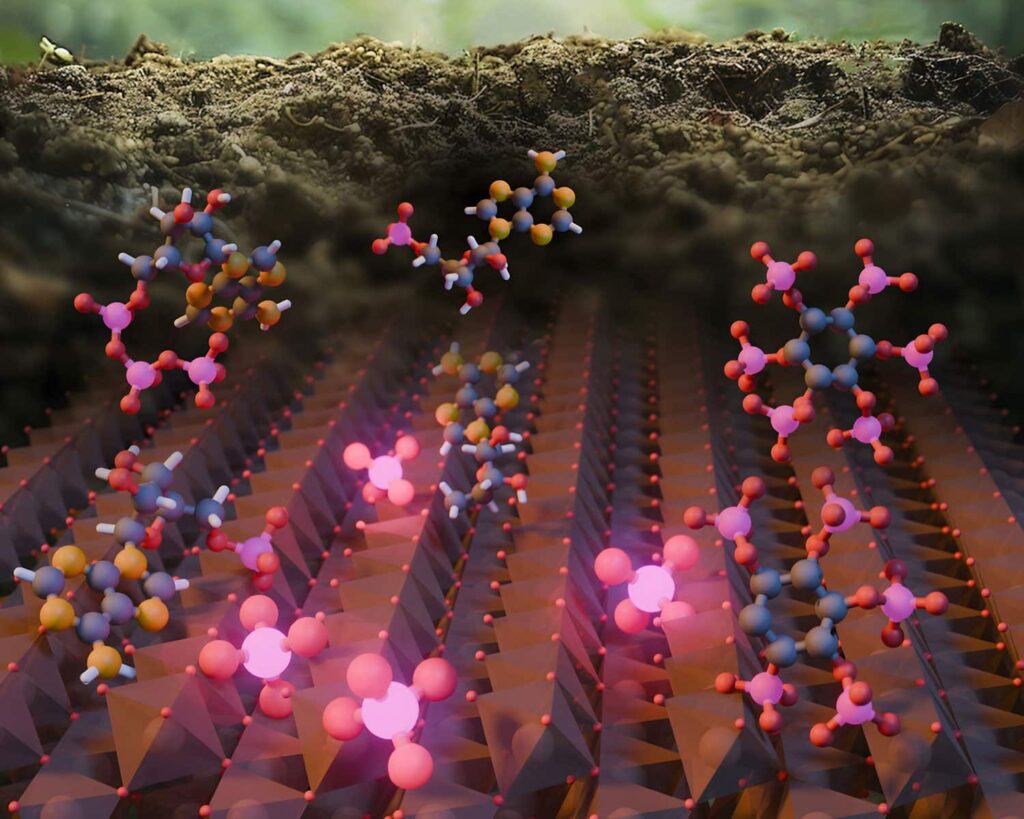Northwestern University researchers have made a groundbreaking discovery about how nature circulates phosphorus. This finding solves a crucial piece of the global phosphorus puzzle. Phosphorus is vital for plant growth and is an essential element in fertilizers.
Without it, farmers cannot guarantee plant health and maximize crop yields. Therefore, understanding Earth’s phosphorus cycle is imperative for safeguarding the world’s food production.
While natural sources of phosphorus are abundant in soils, plants and microbes require inorganic phosphorus for their growth. Organic phosphorus is typically connected to carbon atoms, and plants and microbes produce enzymes to break down organic phosphorus into bioavailable inorganic phosphorus.
Although it was previously believed that only enzymes could drive this transformation, a new study from Northwestern University has revealed an additional player in the phosphorus cycle. Iron oxide, a common mineral in soils and sediments, has been found to catalyze the reaction that converts organic phosphorus into the inorganic form. Surprisingly, iron oxide minerals were also found to recycle phosphorus at a rate similar to that of enzymes in soils.
“Currently, the main source of phosphorus for fertilizers is from mining,” said Northwestern’s Ludmilla Aristilde, who led the work. “It’s a finite resource that we eventually will run out of. According to some estimates, we might run out in as soon as 50 years or in a couple hundred years. We are looking into ways to leverage nature-based solutions for phosphorus recycling because we cannot have food security without it. But before we can do that, we need to understand the underlying mechanisms of natural phosphorus recycling. We found that minerals play an important, and previously unknown, role in the process.”
The decomposition of dead vegetation and microbes in soil results in the release of various nutrients, including DNA and RNA, which are crucial forms of organic phosphorus. Microbes and living plants utilize enzymes to extract phosphorus from nucleotides found in decaying organic matter, making it available as a recycled nutrient.
While it has been widely believed that enzymes are nature’s sole mechanism for recycling organic phosphorus, Aristilde and her colleagues sought to investigate whether an alternative mechanism might be in operation.
“Findings from field studies on the environmental dynamics of phosphorus suggested to consider mechanisms beyond biology for the transformation of organic phosphorus in sediments,” Aristilde said. “My group began looking at minerals, specifically iron oxides because they are known to be able to serve as catalysts.”
Laboratory experiments conducted by Aristilde and her team focused on studying the behavior of phosphorus in soils and sediments containing iron oxide minerals. After a series of experiments and analyses, the researchers discovered transformation products from the reaction in the solution. However, there was a curious absence of part of the inorganic phosphorus.
Due to the known phosphorus-trapping ability of iron oxide, the team decided to take a closer look at the minerals. They utilized a specialized X-ray technique at the Stanford Synchrotron Radiation Lightsource to unravel the mystery.
“Lo and behold, we found that the phosphorus was clinging to the surface of the iron oxide,” Aristilde said. “Basically, the minerals can recycle phosphorus from DNA and RNA molecules. However, not all organic phosphorus is released in the solution because it is stuck to the surface. The X-ray technique allowed us to find that a big fraction of the newly generated inorganic phosphorus was associated with iron oxides.”
Aristilde’s team conducted a study to measure the production of inorganic phosphorus from nucleotides and found that minerals recycle phosphates at a rate comparable to biology. This discovery has significant implications for our understanding of phosphorus recycling and could also offer valuable insights into planetary ecosystems beyond our own.
“Mars is red because it’s full of iron oxides,” Aristilde said. “If there is inorganic phosphorus found to be trapped in them, it is reasonable to ask: ‘Could this phosphorus have an organic origin from life?’”
Journal reference:
Jade J. Basinski, Sharon E. Bone, Annaleise R. Klein, Wiriya Thongsomboon, Valerie Mitchell, John T. Shukle, Gregory K. Druschel, Aaron Thompson & Ludmilla Aristilde. Unraveling iron oxides as abiotic catalysts of organic phosphorus recycling in soil and sediment matrices. Nature Communications, 2024; DOI: 10.1038/s41467-024-47931-z
>>> Read full article>>>
Copyright for syndicated content belongs to the linked Source : Tech Explorist – https://www.techexplorist.com/new-research-finds-missing-piece-earths-puzzling-phosphorus-cycle/86267/#utm_source=rss&utm_medium=rss&utm_campaign=new-research-finds-missing-piece-earths-puzzling-phosphorus-cycle
